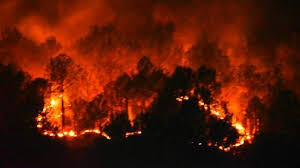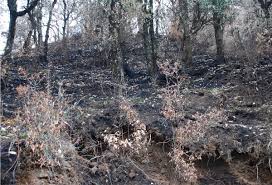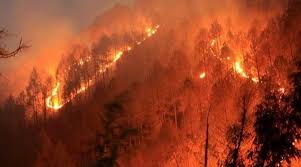Forest fires, each year, destroy millions of hectares of forests worldwide. Apart from an estimated direct loss of USD 3000 million each year, there is a huge loss in terms of lives lost, health problems due to smoke inhalation, loss of soil fertility, increased soil erosion and flooding, and a host of other short term and long term effects of the fires. The recent 2019-2020 season fires in Australia have reportedly affected 186,000 square kilometers of forest, destroyed over 2779 homes and killed at least 34 people. An estimated one billion animals have been killed and some endangered species may be driven to extinction. By January 2020, the smoke from the bushfires had moved approximately 11,000 kilometers across the South Pacific Ocean to Chile and Argentina. NASA estimated that, as of 2 January 2020, 306 million tonnes of CO2 had been emitted from the burning forests. According to a report, forest fires globally contribute 2.5 billion to 4 .0 billion tonnes of CO2 to carbon emissions every year. According to a World Bank report, the total damage and economic loss from forest fires in Indonesia last year amounted to at least USD 5.2 billion. India, with at least twenty five percent of its population dependent upon forests for their livelihood, loses at least Rs. 1100 crores due to forest fires each year. Of this, tangible losses in the form of timber, biodiversity, soil erosion, fuel and fodder, natural regeneration and wildlife amount to at least Rs. 450 crores.
Fires are not always deleterious in nature. In some cases, as for Chir pine forests in India and Eucalyptus forests in Australia, these are a necessity for the regeneration of the crop. Of course, if the fire climbs into the crowns of the trees, it can be devastating. I was in Australia in 1995, driving through Victoria, when my guide and I suddenly came face to face with a forest conflagration. The first indication we had that something was amiss was when dozens of kangaroos came bounding up the road, and flashed past our car, one almost landing on the roof. Patrick (Pat), looking worried, slowed down the car. The terrain was slightly rolling and, as we crested a rise, in the far distance we could see flames in the valley. Interestingly, there was very little smoke. “Let’s stop and take some pictures,” I said. Pat, still looking worried, shook his head. “No,” he said. “Get back in the car. We need to turn back and get out of here. The fire is going to catch up with us in a jiffy.” I was dubious. How could a fire travel so fast, I thought. Furthermore, there were treeless grasslands interspersed with the eucalyptus stands, which should deter the fire from reaching us. Nevertheless, I got back into the car that Pat had turned around in the meanwhile. As we drove at near breakneck speed towards Ballarat, Pat rolled the sun roof back and kept casting worried glances at the sky. Soon I too could spot wisps of smoke in the sky above us. Suddenly there was a ‘Whooosh’ and it seemed a ball of fire jumped over our car and set afire the trees ahead of us. Hastily rolling the sun roof closed, Pat increased speed and flashed through the burning woods. He did not take his foot off the accelerator till we were well clear of the forests, and in farming country north of Ballarat. We could see fire engines lined up along the highway, all set to take on the fire, if it got too close to the city. Patrick stopped the car at a Pub and, as we sat quenching our throats, I asked what had happened. How had the fire travelled so fast? “Well,” said Pat, “That bushfire out there climbed into the trees and the oil from the Yukes (eucalyptus) must’ve ignited in the air. With wind behind its back, the fireball jumped from bush to bush.” Even the densest of forests in Australia are addressed as ‘bush’ in Australia. “We were lucky, mate, to have turned round when we did,” he continued, “Else we would be roast meat by now.”
After the fire had burnt itself out, Pat and I drove back to the now blackened and ash strewn forests. Smoke was still curling up from stumps and fallen logs, and we could spot charred carcasses of kangaroos, koalas and birds on the forest floor. It was a sad and depressing sight. At the same time I could feel something falling on my head and neck. At first I thought it was ash from the burnt leaves but, when I gathered a pinch from the back of my neck, I saw these were fine seeds of Eucalyptus. The heat of the flames had opened up the seed pods and these seeds were now raining down to create a new forest. Soon the forest floor would get covered with a green mantle of eucalyptus seedlings that would, in time, grow into trees to replace the ones that had been destroyed. Eucalypts also have a thick bark and, after some time, buds deep under the bark (epicormic buds) would sprout and give rise to new branches and leaves along the trunk. Nature has a way of healing itself.
As with the eucalypts, Chir Pine trees in the lower Himalaya also are adapted to frequent fires. The bark is corky and thick, and protects the underlying tissues of the trunk. Fires keep the soil below the pine trees dry and hard, thereby keeping it well suited to support the growth of new pine seedlings. No other tree can survive in this harsh habitat. Many pseudo environmentalists and ecologists maintain that fires are harmful and should be prevented from occurring. If fires were not to occur, the pine forests would gradually become unable to regenerate in situ and, in time, change to more green and moist vegetation consisting of broadleaf trees such as oaks. Forestry practices have, for over a hundred years, aimed at maintaining the status quo in the Himalayan pine forests. The pine trees yield resin when tapped, and this resin, when processed, yield Rosin and Turpentine Oil, both extremely valuable materials for the maintenance and upkeep of the wooden ships in the past. In fact these are still labeled as “Naval Stores” in shipping parlance. Today, of course, these products are no longer used for the shipping industry, but are much in demand for pharmaceuticals, polishes, paints, varnishes and even perfumes. The best quality printing inks use rosin derived from pine trees to give them the required consistency and shine.
Come April/May, and all foresters in the lower hills get extra careful as this is the time when the Chir (Pine) forests are at their most vulnerable. It is during this period, as the summer advances, that fires – accidental or deliberate – rage through the forests, destroying all in their path, living or dead. Detritus collects on the forest floor all through the year. Dry pine needles, dead branches and twigs, fallen trees, dried bushes – all provide ready fuel for the fires! The fact that pine trees store resin in their wood makes the material much more inflammable. Add to that the practice of tapping the trees for resin extraction, and you have a powder keg just waiting to explode!
Nearly 60 percent of the forests of Rajgarh Forest Division, in 1974, comprised of Chir pine. By the end of March, firefighting tools and equipment would be stocked and stored at strategic locations all over the Chir forest zone, and extra staff would be recruited to act as watchers and firefighters. Villagers would be trained and exhorted to assist in fighting fires alongside the forest staff. At the same time, prayers would be offered to propitiate the rain gods, requesting an early onset of the monsoon. Then, with bated breath, everybody would wait for the fires. The next three months were the busiest ones for the field staff. As they put out one fire, news would arrive of another some distance away. If a fire was not completely extinguished, it could flare up again after a few hours. All this kept the field staff in a tizzy, and the supervisory staff on tenterhooks, all summer.
Although fires in the chir forests were almost an accepted annual feature, every three or four years we would have major fires spread to almost all parts of the state. 1975 was one of those years. Conflagrations erupted all over the Division, and the field personnel were on their toes day and night. All the officers at headquarters were also in the field supervising and directing firefighting operations. I too was deputed to a vulnerable part of the division, to assist the local staff. This was when I discovered, for the first time, how difficult the life of a forest guard really was. I had gone out with the staff one morning to inspect some plantations, when we received a message to rush post haste to a forest some two kilometers away, where a fire had begun. We raced off and soon caught up with the staff engaged in trying to control the fire. It appeared that the fire had started in the adjoining valley and had climbed up the opposite slope the day before. As we climbed up the unburnt slope, we could see smoke and flames across the ridge above and hear the crackling sounds of the approaching fire. Soon enough about ten of us reached the ridge and could feel the heat of the fire rapidly moving uphill. The only tools we had for fighting the fire were leafy branches of bushes, which we used to ‘beat out’ the fire. How horribly ill equipped we were! Fortunately, this fire was a ‘ground’ fire, which was burning the bushes and debris in the forest floor, and just licking the bases of the trees.
Imitating the others, I too hastily tore off a few leafy branches of some bushes and began trying to beat out the flames which had, by now, reached the ridge. I thought our efforts were paying off, when I heard a shout warning me to look behind me. It was scary. A small fire had appeared about fifty meters below me and was rapidly spreading. Now how could that happen, I wondered. There had been no fire when we were climbing up the very slope some twenty minutes ago! That was when I noticed some burning pine cones rolling down the slope. It was these that were setting fire to the bushes downhill! I noticed my fellow workers running along the contour as fast as their legs could carry them, and I followed suit. Huffing and panting, we got to a rocky outcrop, out of the way of the fire that was barely ten meters away by the time we reached the rocks. All of us were covered with soot, our faces streaked with rivulets of sweat, our arms scratched and clothes blackened and dotted where sparks had fallen; but all laughing at the sheer thrill of having escaped a gory end. I could not help but admire the spirit of these hardy villagers and foresters who daily looked death in the face, and could still laugh away their fears. I thanked the Lord for sparing my life that day, and wowed to never again be careless in future – at least not where fire was concerned.
I am a retired forester, with keen interest in ecology, environment and wildlife. Currently residing in Solan and working as a freelance Consultant in the above fields.






